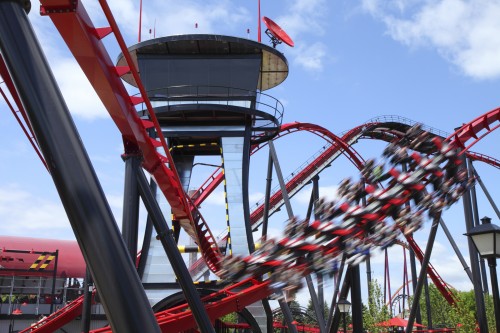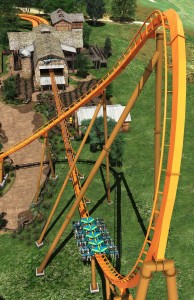Batwing, Demonic Knot, and Cobra Roll, Oh My!
If your idea of the perfect vacation involves a Top Hat, Pretzel Knot, Immelmann Loop, and Corkscrew, then you are officially a roller coaster junkie. How many thrill elements can you name?
Very few experiences can equal the adrenaline rush and stomach tightening provided by today’s coasters. That extreme experience does not happen easily; ride designers work hard to integrate over 30 types of thrill elements into a calculated choreography to produce a unique and thrilling ride that takes your breath away.
With theme park attendance experiencing strong growth over the past two years, park owners and ride designers are competing at a level never seen before to create the ultimate one-of-kind guest experience. The integration of special effects, motion simulation, and theming within ride environments has resulted in an even wider array of guest experiences.
Ride designers employ a variety of technical elements in the following categories to enhance and heighten the thrill of the ride.
- Speed – Acceleration and sudden launches heighten the thrill effect of roller coasters. Ferrari World’s Formula Rossa which reaches the speed of 149 mph, generating 1.7 Gs
- Dips, Dives & Drops – Extreme heights, soaring, and steep drops can take your breath away. Kingda Ka at Six Flags Great Adventure is 456 feet tall (that’s 45 stories) with a 418 foot drop. A 570 foot tall coaster named Skyscraper is planned for Orlando in 2016.
- Turns – Banked, Over-banked (over 90 degrees), and Horseshoe Turns. Six Flags Great America’s newest ride Goliath features three intense over-banked turns, a 180-degree zero G-roll twist, and two wild inversions.
- Inversions – like flipping head over heels? Inversions characterize the new breed of roller coasters and include a wide variety of types: roll out, loop, wraparound, interlocking loops, pretzel loop, pretzel knot, corkscrew, interlocking corkscrew, zero-gravity, Immelmann, sea serpent roll, Norwegian loop, inline twist, barrel roll, and batwing.
Ride designers use computer modeling to test and predict the functionality of the coasters. Employing modeling software, designers are able to manipulate elements, optimizing a ride’s final layout. Analysis of the ride’s performance, structural integrity, and g-forces are facilitated by computer modeling. As a result, ride fabrication has become even more precise.
Ride architects also use 3-D computer modeling to integrate rides into the very real constraints of each theme park. Existing park infrastructure including utilities and roads, as well as adjacent attractions, all impact the integration of a new ride into the park.
Using computer modeling, we can evaluate theming elements to determine their fit with the new ride. At Six Flags Great America, we used computer modeling to predict the flight path of the X Flight coaster. We were able to create an adrenaline-pumping moment by using computer modeling to test an extreme fly-through in which the coaster speeds toward a control tower structure before making a last-minute vertical flip to fit through a keyhole cutout.
A fun way to learn about coasters and plan your trip to parks is by reading Arthur Levine’s features in AboutTravel.com or go directly to the theme park web sites for specific details.
Many theme park companies including Six Flags and Holiday World have announced their new roller coaster rides for 2015. It will be fun to experience the new roller coaster innovations in the coming season. We can’t wait!





